 W
WAn A unit, in railroad terminology, is a diesel locomotive equipped with a driving cab and a control system to control other locomotives in a multiple unit, and therefore able to be the lead unit in a consist of several locomotives controlled from a single position. This terminology is generally used in North America, since only there was it commonplace to build B units—cabless locomotive units which normally could not lead a train.
 W
WAn adhesion railway relies on adhesion traction to move the train. Adhesion traction is the friction between the drive wheels and the steel rail. The term "adhesion railway" is used only when it is necessary to distinguish adhesion railways from railways moved by other means, such as by a stationary engine pulling on a cable attached to the cars or by railways that are moved by a pinion meshing with a rack.
 W
WThe Arnoux system is a train articulation system, for turning on railroad tracks, invented by Jean-Claude-Républicain Arnoux and patented in France in 1838. Arnoux was the chief engineer of the Ligne de Sceaux which was originally built with very tight radii in the area around Sceaux, Hauts-de-Seine.
 W
WAn atmospheric railway uses differential air pressure to provide power for propulsion of a railway vehicle. A static power source can transmit motive power to the vehicle in this way, avoiding the necessity of carrying mobile power generating equipment. The air pressure, or partial vacuum can be conveyed to the vehicle in a continuous pipe, where the vehicle carries a piston running in the tube. Some form of re-sealable slot is required to enable the piston to be attached to the vehicle. Alternatively the entire vehicle may act as the piston in a large tube or be coupled electromagnetically to the piston.
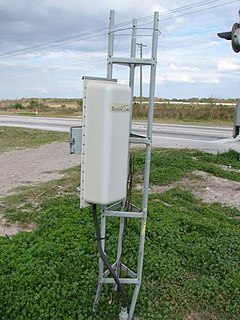 W
WAutomatic equipment identification (AEI) is an electronic recognition system in use with the North American railroad industry. Consisting of passive tags mounted on each side of rolling stock and active trackside readers, AEI uses RF technology to identify railroad equipment while en route.
 W
WAutomatic train operation (ATO) is an operational safety enhancement device used to help automate the operation of trains. The degree of automation is indicated by the Grade of Automation (GoA), up to GoA level 4. ATO is primarily used on automated guideway transit and rapid transit systems where it is easier to ensure the safety of humans. On most systems, there is a driver present to mitigate risks associated with failures or emergencies.
 W
WAn axle or axletree is a central shaft for a rotating wheel or gear. On wheeled vehicles, the axle may be fixed to the wheels, rotating with them, or fixed to the vehicle, with the wheels rotating around the axle. In the former case, bearings or bushings are provided at the mounting points where the axle is supported. In the latter case, a bearing or bushing sits inside a central hole in the wheel to allow the wheel or gear to rotate around the axle. Sometimes, especially on bicycles, the latter type axle is referred to as a spindle.
 W
WA bogie is a chassis or framework that carries a wheelset, attached to a vehicle—a modular subassembly of wheels and axles. Bogies take various forms in various modes of transport. A bogie may remain normally attached or be quickly detachable ; it may contain a suspension within it, or be solid and in turn be suspended ; it may be mounted on a swivel, as traditionally on a railway carriage or locomotive, additionally jointed and sprung, or held in place by other means.
 W
WA bogie is a chassis or framework that carries a wheelset, attached to a vehicle—a modular subassembly of wheels and axles. Bogies take various forms in various modes of transport. A bogie may remain normally attached or be quickly detachable ; it may contain a suspension within it, or be solid and in turn be suspended ; it may be mounted on a swivel, as traditionally on a railway carriage or locomotive, additionally jointed and sprung, or held in place by other means.
 W
WA buffer is a part of the buffers-and-chain coupling system used on the railway systems of many countries, among them most of those in Europe, for attaching railway vehicles to one another.
 W
WA builder's photo, also called an official photo, is a specific type of photograph that is typically made by rail transport rolling stock manufacturers to show a vehicle that has been newly built or rebuilt. The builder's photo is meant to show an overview of the basic exterior form of a unit of rolling stock. Photographs made by railfans that show similar features to builder's photos are sometimes informally referred to as roster shots. Builder's photos were also made by some automobile manufacturers to show a representative sample of new models they produced.
 W
WA cable car is a type of cable railway used for mass transit in which rail cars are hauled by a continuously moving cable running at a constant speed. Individual cars stop and start by releasing and gripping this cable as required. Cable cars are distinct from funiculars, where the cars are permanently attached to the cable.
 W
WA cable railway is a railway that uses a cable, rope or chain to haul trains. It is a specific type of cable transportation.
 W
WClass districts were a classification system for railway goods wagons used by the Deutsche Reichsbahn (1920–1945) in Germany between the wars.
 W
WThe track on a railway or railroad, also known as the permanent way, is the structure consisting of the rails, fasteners, railroad ties and ballast, plus the underlying subgrade. It enables trains to move by providing a dependable surface for their wheels to roll upon. For clarity it is often referred to as railway track or railroad track. Tracks where electric trains or electric trams run are equipped with an electrification system such as an overhead electrical power line or an additional electrified rail.
 W
WA derailment occurs when a vehicle such as a train runs off its rails. Although many derailments are minor, all result in temporary disruption of the proper operation of the railway system and they are potentially seriously hazardous to human health and safety. Usually, the derailment of a train can be caused by a collision with another object, an operational error, the mechanical failure of tracks, such as broken rails, or the mechanical failure of the wheels. In emergency situations, deliberate derailment with derails or catch points is sometimes used to prevent a more serious accident.
 W
WA drop table or wheel drop is a device used in railway engineering during maintenance jobs that require the removal of locomotive or rolling stock wheelsets. The machine is built in a drop pit allowing a locomotive or rolling stock to be rolled onto it, avoiding the need for heavy cranes or jacks to lift the vehicle off the rails.
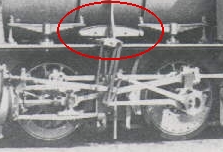 W
WAn equalising beam, equalising lever or equalising bar links the suspension of two or more adjacent axles of a vehicle with more than two axles, especially railway locomotives. Its job is to provide 'compensated' springing, i.e. to ensure an even and statically determinate distribution of load to all the axles on uneven terrain or poorly laid track. The function of an equalising lever thus corresponds roughly to that of axle compensators or rockers (Achswippen).
 W
WThe Fell system was the first third-rail system for railways that were too steep to be worked by adhesion on the two running rails alone. It uses a raised centre rail between the two running rails to provide extra traction and braking, or braking alone. Trains are propelled by wheels or braked by shoes pressed horizontally onto the centre rail, as well as by the normal running wheels. Extra brake shoes are fitted to specially designed or adapted Fell locomotives and brake vans, and for traction the locomotive has an auxiliary engine powering horizontal wheels which clamp onto the third rail. The Fell system was developed in the 1860s and was soon superseded by various types of rack railway for new lines, but some Fell systems remained in use into the 1960s. The Snaefell Mountain Railway still uses the Fell system for (emergency) braking, but not for traction.
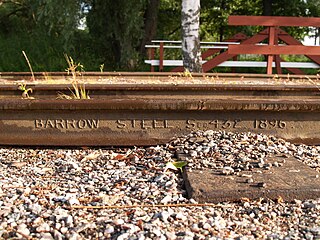 W
WThe rail profile is the cross sectional shape of a railway rail, perpendicular to its length.
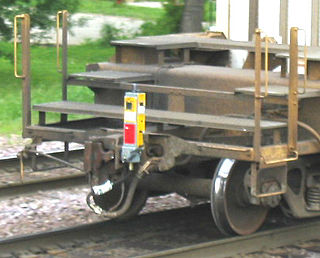 W
WThe end of train device (ETD), sometimes referred to as an EOT, flashing rear-end device (FRED) or sense and braking unit (SBU) is an electronic device mounted on the end of freight trains in lieu of a caboose. They are divided into three categories: "dumb" units, which only provide a visible indication of the rear of the train with a flashing red taillight; "average intelligence" units with a brake pipe pressure gauge; and "smart" units, which send back data to the crew in the locomotive via radio-based telemetry. They originated in North America, and are also used elsewhere in the world, where they may include complete End of Train Air System (ETAS) or Sense and Brake Unit (SBU) devices.
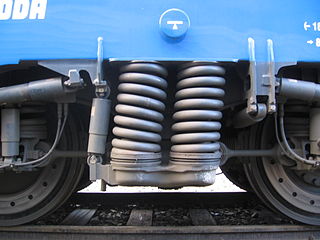 W
WFlexicoil suspension is a type of secondary suspension for railway vehicles, typically having steel coil springs between the bogie trucks and chassis|frame of a passenger coach, goods freight wagon, or locomotive. Suspension systems using steel springs are more common than those with air springs, as steel springs are less costly to make, relatively wear resistant, and require less maintenance.
 W
WA funicular is a transportation system that uses cable-driven cars to connect points along a steep incline. By definition, a funicular uses two counterbalanced passenger cars attached to opposite ends of the same cable, which is looped over a pulley at the upper end of a track.
 W
WA gangway connection is a flexible connector fitted to the end of a railway coach, enabling passengers to move from one coach to another without danger of falling from the train.
 W
WIn rail transport, head-end power (HEP), also known as electric train supply (ETS), is the electrical power distribution system on a passenger train. The power source, usually a locomotive at the front or 'head' of a train, provides the electricity used for heating, lighting, electrical and other 'hotel' needs. The maritime equivalent is hotel electric power. A successful attempt by the London, Brighton and South Coast Railway in October 1881 to light the passenger cars between London and Brighton heralded the beginning of using electricity to light trains in the world.
 W
WHunting oscillation is a self-oscillation, usually unwanted, about an equilibrium. The expression came into use in the 19th century and describes how a system "hunts" for equilibrium. The expression is used to describe phenomena in such diverse fields as electronics, aviation, biology, and railway engineering.
 W
WAn inclined elevator or inclined lift is a form of a cable railway system that can travel up a steep gradient.
 W
WKarTrak, sometimes KarTrak ACI (for Automatic Car Identification) is a colored bar code system designed to automatically identify rail cars and other rolling stock. KarTrak was made a requirement in North America, but technical problems led to abandonment of the system in the late 1970s.
 W
WA locomotive winch is a technical device for moving stabled railway locomotives.
 W
WLocotrol is a product of GE Transportation that permits railway locomotives to be distributed throughout the length of a train. It is installed on more than 8,500 locomotives around the world, sending signals from the lead locomotive and via radio to the remote control locomotives.
 W
WA point machine is a device for operating railway turnouts especially at a distance.
 W
WA rack railway is a steep grade railway with a toothed rack rail, usually between the running rails. The trains are fitted with one or more cog wheels or pinions that mesh with this rack rail. This allows the trains to operate on steep grades above 10%, which is the maximum for friction-based rail. Most rack railways are mountain railways, although a few are transit railways or tramways built to overcome a steep gradient in an urban environment.
 W
WA Rail Adhesion Car or Rail Adhesion Train is a modified vehicle used on a rail adhesion system where the standard equipment does not have locomotives' rail sanding ability. In particular, it may involve tanks and dispensing equipment installed in an electric subway or rail car that is run over the rails alone or in a train to dispense sand when needed. Because of space limits under the cars, the sand or gel/sand mix tanks are installed inside the passenger space.
 W
WThe rail profile is the cross sectional shape of a railway rail, perpendicular to its length.
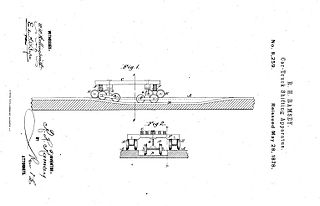 W
WIn railroad industry, the Ramsey car-transfer apparatus was a device to replace bogies on railroad cars to permit transfer of a train between railroad lines with different gauge.
 W
WIn railroading, slack action is the amount of free movement of one car before it transmits its motion to an adjoining coupled car. This free movement results from the fact that in railroad practice cars are loosely coupled, and the coupling is often combined with a shock-absorbing device, a "draft gear", which, under stress, substantially increases the free movement as the train is started or stopped. Loose coupling is necessary to enable the train to bend around curves and is an aid in starting heavy trains, since the application of the locomotive power to the train operates on each car in the train successively, and the power is thus utilized to start only one car at a time.
 W
WA span bolster, in rail terminology, is a beam or frame used to link two trucks (US) or bogies (UK) so that they can be articulated together and be joined to the locomotive or railroad car at one rotating mounting point. In effect, they make one "super-truck" out of the two, while permitting each truck to move relative to the other.
 W
WBetween 1892 and 1906 Chicago had three cable car tunnels under the Chicago River. Two were built for pedestrian and horse traffic and later converted, the third was built specially for cable-cars. After cable service ended they would be used by electric streetcars.
 W
WTotal Operations Processing System (TOPS) is a computer system for managing the locomotives and rolling stock owned by or operated on a rail system. It was originally developed by the Southern Pacific Railroad, the Stanford University and IBM and was introduced on the railroad in 1968; despite being widely sold to the United States railroads, the system found greater success in the United Kingdom, where it has been used by British Rail (BR) and its successors.
 W
WA train inspection system is one of various systems of inspection which are essential to maintain the safe running of rail transport.
 W
WIn rail transport, head-end power (HEP), also known as electric train supply (ETS), is the electrical power distribution system on a passenger train. The power source, usually a locomotive at the front or 'head' of a train, provides the electricity used for heating, lighting, electrical and other 'hotel' needs. The maritime equivalent is hotel electric power. A successful attempt by the London, Brighton and South Coast Railway in October 1881 to light the passenger cars between London and Brighton heralded the beginning of using electricity to light trains in the world.
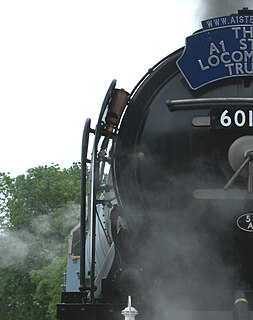 W
WA train whistle or air whistle is an audible signaling device on a steam locomotive, used to warn that the train is approaching, and to communicate with rail workers. Modern diesel and electric locomotives primarily use a powerful air horn instead of a whistle as an audible warning device. However, the word whistle continues to be used by railroaders in referring to such signaling practices as "whistling off".
 W
WA yaw damper is a transverse mounted shock absorber used to prevent railcars and locomotives from swaying excessively from side to side. Yaw dampers prevent locomotives and passenger railcars from striking station platforms as they roll past them and reduce the gap that must be left between the railroad vehicle and the platform, improving safety.